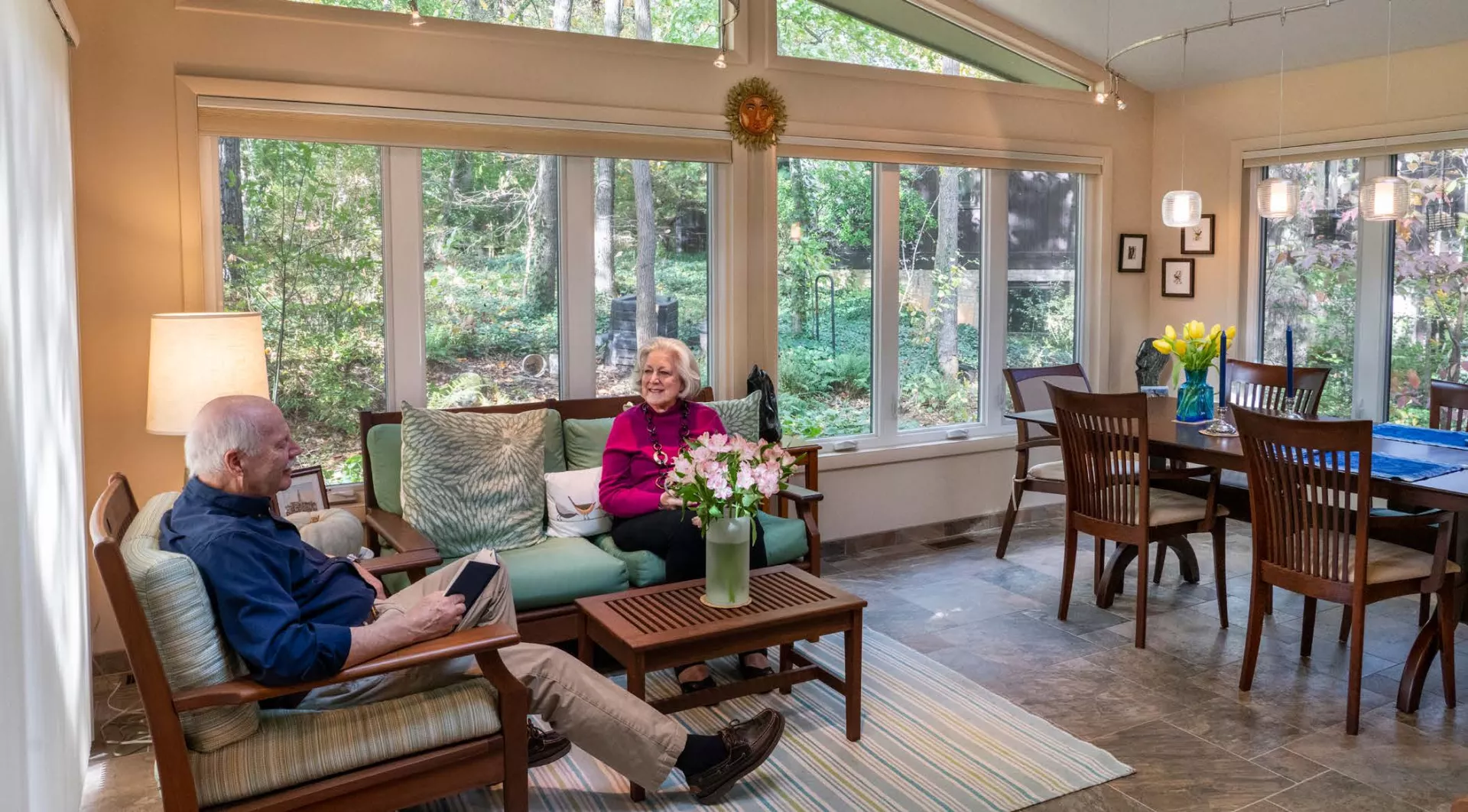Barbara and Gary Allen have been planning for the future for the last 12 years. Over time, they have slowly and lovingly renovated their Northern Virginia home, making thoughtful changes that will help them live there for many years to come.
They tackled practical improvements one-by-one. In the bathroom, they replaced the tub with a walk-in shower that has a seat and a handheld sprayer; raised the height of the toilet; and added an adjustable magnifying mirror so Barbara can more easily apply eye drops for her glaucoma.
The couple also lowered the outdoor steps leading to their entry, put in a sturdier handrail, and replaced windows in their bedroom with a sliding glass door to give them another exit. The other exits are at the other end of the house, which would have been hard for them to reach quickly in a fire.
But just as important, they wanted to design their home to give them joy. So they converted a large porch into a comfortable all-season space.
“This room was the improvement that I appreciate the most,” says Barbara, a retired special education teacher. “We wanted our house to meet our needs, but also hoped to make it an inviting place. We love it here and want to stay here as long as we can.”
When the unexpected happens
Nearly 400 miles to the south, in Bristol, Va., Anna and Ralph Booher needed to make changes to their home after Ralph took a fall, cracking his hip and sustaining other injuries.
The couple, who are both retired social studies teachers, made their bathroom handicap accessible, got rid of rugs, purchased a lift chair, and raised and widened their driveway to make it easier to get from the car to the house.
The Boohers also replaced doorknobs with lever handles, rearranged furniture to make space for a wheelchair or walker, and are in the process of fixing uneven flooring.
“We wanted it to be safe for each stage of our lives, but also don’t want to leave [our home],” Anna says. “I believe in one saying that I repeated throughout my career and I think it applies here: ‘If you fail to plan, you fail.’”
Safety first
As people live longer, “aging in place” has become a growing trend among older adults. So much so that builders are now trained and certified by the National Association of Homebuilders (NAHB) as aging-in-place specialists. For many, this is the fastest growing part of their business.
NAHB provides a checklist of improvements that can help people stay in their homes as they grow older. Some move bedrooms to the first floor; add ramps or wider doorways to accommodate wheelchairs and walkers; or make substantial renovations to bathrooms, like the Allens and Boohers did.
But smaller fixes can also make living at home more comfortable, such as rearranging cabinets to put the most frequently used items in easy-to-reach places; adding lighting in dark areas; moving a microwave from over the stove to a countertop; and installing faucets and doorknobs that are easier on arthritic hands.
Renovations for a range of budgets
Taking care of the most important items—including the bath, living area, and kitchen—could cost about $250 per square foot, or about $150,000 for an average house, estimates Steve Cunningham, head of the NAHB remodelers’ group. That’s a staggering figure for many retirees, but more affordable options can also have a big impact.
The shower is by far the most dangerous place for elderly people, Cunningham notes. Simply replacing a tub with a walk-in shower and adding grab bars can be much more economical, ranging from $750 to $2,500.
Similarly, moving a bedroom downstairs could cost $50,000, if you build an addition. Or you can reconfigure an existing room downstairs, and then all you need is some help moving furniture around.
It’s worth comparing the cost of renovations to the cost of an assisted living facility, says aging-in-place consultant Mark Hager. “[Assisted living] costs considerably more a month than what a $150,000 renovation costs spread over several years,” he says, adding that retrofitting a home can extend the owner’s time there by 15 years.
The Boohers have remodeled their home several times, spreading out the cost over many years.
“We have thought carefully about what needed to be done here,” Anna says. “We also have had several former students do the work. They’ve been very generous with their advice and have done an excellent job. That’s one benefit of being a teacher.”
Planning is everything
Designing your home for aging-in-place means planning ahead and making changes before you actually need them, Hager says. “Most homes in this country were designed for the average 22-year-old, … but what about when we are 80?” he adds.
To get started, Hager recommends consulting with an occupational therapist to determine your specific needs and then getting bids from multiple builders.
Ever the planners, Allen and her husband have researched nearby assisted living facilities, so they are prepared if that step becomes necessary.
“We are realistic and prepared to do that, but why not stay in your home as long as possible.”


